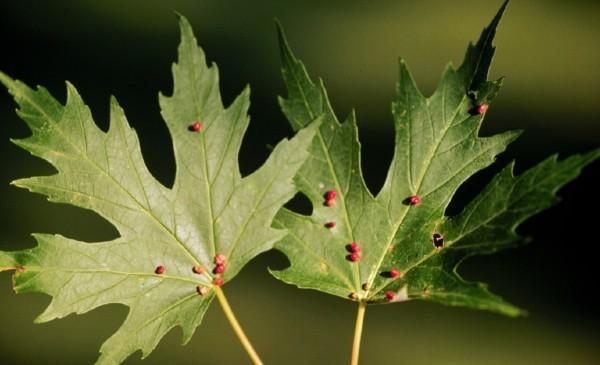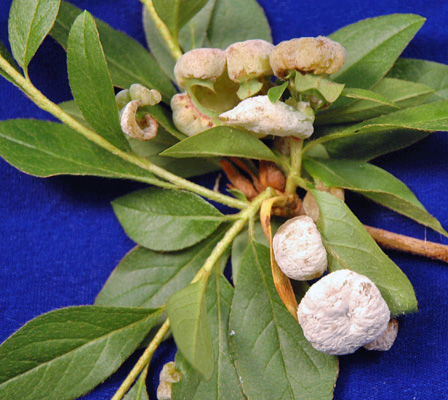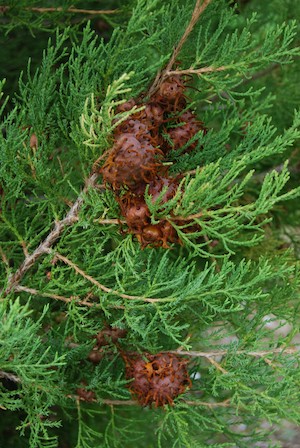Got Plant Galls?
by Carolyn R. Casey, Fairfax Master Gardener

Maple leaf gall
As I was walking in my garden, I noticed small bumps on the foliage of some of my trees. I spent time investigating these new and interesting growths and found out that the small bumps are created by a hastened growth phase of new leaves, shoots and flowers that occur in the late spring. They are due to the salivary secretions released by insects and/or mites chewing on the plant. The most common causes of galls are insects, mites, nematodes, fungi, bacteria and viruses. These problems cause plants to produce an increase of their normal growth hormones. This produces enlarged cell size or cell numbers, and these are called galls.
Galls may be caused by insects that are feeding or are due to egg laying insects like aphids, midges, wasps or mites. The eggs inside the galls will develop, feed and grow inside them. Once a gall starts to form, it will continue to grow even after the insects inside die.
Galls produce abnormal vegetative growth. They can appear as bumps, balls, knobs, lumps or warts. Every growth is characteristic to the causal organism. They are discovered due to their standout shapes and their colors of red, green, yellow or black.
There are several types of galls. The most common type of gall is the leaf gall. It forms on leaf blades or petioles and appears as leaf curls, blisters, nipples or erineums. Erineums are hairy, felt-like growths that appear on the top or lower leaf surface. There are stem and twig galls. These cause the stems and twigs to be deformed and range from slight swellings to large knot-looking growths. Bud or flower galls cause the buds and flowers to be deformed in size and shape.
Galls may cause damage to plants since they need nutrients like the rest of the plant and therefore steal vital nutrients from the plant and affect its growth. Usually galls on a plant are not enough to harm the plant but can cause problems for very young plants. If galls are on a plant for several years, it may cause damage to the plant. Established plants are not typically affected by the insects that create galls. There is a relationship between the host plant and the gall maker. Gall producers each have a specific kind of plant to which they are attracted.
The weather, plant vulnerability and pest populations affect the occurrence of galls on plants from year to year. Oak trees are hosts to over 500 different wasps, aphids, mites and midges that cause galls on leaves and twigs.

Azalea Exobasidium Gall
Gall mites are very small, typically white, sausage shaped mites with two pairs of legs. They are found in erineum galls, and some types of pouch galls are often found on buds of leaves. Erineum galls have hair-like growths on the leaf surface, and pouch galls form pouch shaped deformities that create depressions on the leaf surface. Other gall mites create deformities to flowers and buds.
The aphid genus Pemphigus includes several species that form galls on the leaves or petioles of cottonwoods, aspens and willows. The tiny aphid-like insect genus Phylloxera causes galls on the stems and leaves of pecan and grape plants. Common galls caused by psyllids, also known as jumping plant lice, are found on hackberry leaves and buds.
Gall midges are a large group of delicate flies that are less than 1/4 inch long (6 mm). They cause bud galls, blister galls and galls on leaves and other plant tissues. For example, gall midges cause leaf spot galls, which are characterized by noticeable leaf discoloration, and vein pocket galls.
The most common gall makers are gall wasps. Most gall wasps belong to the family Cynipidae but a few sawflies and chalcid wasps also cause galls. Gall wasps are commonly found on oaks, but roses, maples and other plants also serve as viable host plants. The galls they form may be located on any part of the plant, in diverse forms and shapes.
Some gall makers can cause serious damage to valuable plants. A few mites and midges are serious pests of fruit trees, roses and other flowers. A few gall wasps cause large, irregular galls on oak branches that can effectively girdle the branch and occasionally cause tree mortality. Plant galls can become common enough to make the plant’s appearance unattractive, which can limit the marketability of affected nursery plants.
Despite the visible effect that substantial gall infestations can cause, the connection between the plant host and the gall maker is so balanced that the gall maker seldom kills the overrun plants. This makes management of gall insects challenging and frequently unwarranted. Some types of trees seem to be less prone to gall formation. Research suggests that less susceptible trees have leaves that open later in the season.

Crown gall caused by bacteria
Crown gall affects many plant ornamentals, fruit trees and brambles. It is caused by the bacterium Agrobacterium tumefaciens and is common on roses and euonymus. Many woody plants are susceptible to crown gall including cypress, hibiscus, flowering peach, privet, viburnum and willows. It is soil borne and enters the plant through wounds in the bark. The bacterium infects the host plant to produce hormones that cause abnormally rapid cell division and enlargement of stem or root tissue. The position of the gall is determined by the location of the wounds. Galls range in size from a fraction of an inch to several inches in diameter. Plant tissue found inside the galls is disorganized.
There are many products that can be produced from galls. Tannic acid is an essential product produced from galls and is used in some insecticides. The finest quality inks have been made from galls. Also, galls are used as food. The “pomme de sauge,” in the Near East is valued as food due to its aromatic and acid flavor. In the Ozarks of the United States, a tiny black gall fed to livestock contains 64 percent carbohydrates and more than 9 percent protein. Also, after the gall emerges naturally or becomes a meal for another creature, the empty gall can be used as a shelter for other insects. The cavity created by the goldenrod gall can be used as a nursery by a certain type of wasp. The wasp lays her eggs in the gall, puts food in it and then plugs the old exit hole with a mud stopper. Midges, aphids, plant bugs, flea beetles, springtails, thrips, mites and spiders often take refuge in willow pine cone galls. In fact, one study of such a gall revealed that there were 31 different species of insects within the gall — 10 inquilines, 16 parasites, and 5 transients (insects just passing through).
Galls are frequently invaded by secondary bacteria and fungi. These types of galls may interfere with water and nutrient absorption and result in death. In some plants the damage is cosmetic. Most galls are on the stems or trunks at the crown. Some galls may be below the soil line. These types of galls appear after the plant has been growing for one or more seasons. According to the 2023 Pest Management Guide there are no chemical controls for home grower use.

Cedar apple rust galls on cedar
Fungal gall examples are cedar-apple rust fungus, (Gymnosporangium juniperi-virginianae) and black knot (Apiosporina morbosa). These fungus galls are made up of fungal tissue mixed with plant tissue. The galls disrupt vascular flow, and heavy galling causes stem dieback. The fungus infects newly developing twigs in the spring and production of infectious spores occurs about two years after the initial infection. According to the 2023 Pest Management Guide, Immunox is the most effective fungicide listed here that adequately protects against rusts. In some years rust infection occurs later than petal fall. Where rust pressure is heavy, two or three sprays of Immunox may be required to cover the six-week period of fruit and foliage susceptibility from pink to four weeks after petal fall.
If desired for cosmetic purposes, galls on larger trees may be removed surgically. Disinfest tools between cuts with rubbing alcohol or a solution of 1 part bleach to 9 parts water. Galls should be removed during late fall or midsummer when sap flow is minimal.
According to the 2023 Pest Management Guide, the approved pesticide for gall insects is Carbaryl. Treatments are effective when insects are active before galls appear in spring. Most gall insects sting or feed on the host to incite the galls and leave the galls when mature. Disposing of galls is not effective in reducing pests unless they can be cut out while they are actively growing, such as the horned oak gall and the gouty oak gall. Biological controls are not known at this time. For cultural control, maintain good overall health of the plant. Fertilize in the summer, irrigate during dry times and prune limbs regularly. If galls are numerous, some can be pruned out and destroyed.
Resources
Galls Made by Wasps, Eric Day and Theresa Dellinger, Virginia Cooperative Extension
Crown Gall of Woody Ornamentals, G.H. Lacy and M.A. Hansen, Virginia Cooperative Extension
Insect and mite galls, Jeffrey Hahn, University of Minnesota Extension
Plant Galls, The Morton Arboretum
Plant Galls Caused by Insects and Mites, Tom Royer and Eric Rebek, Oklahoma State University